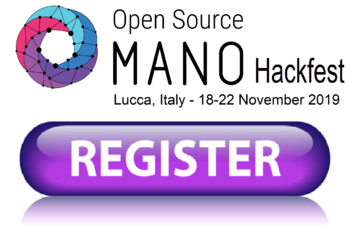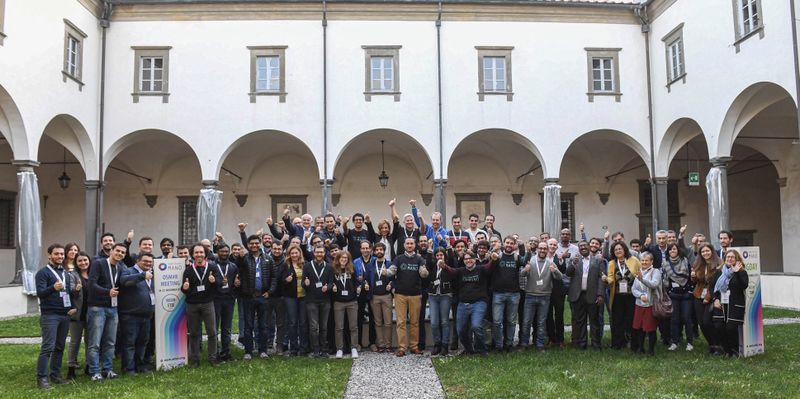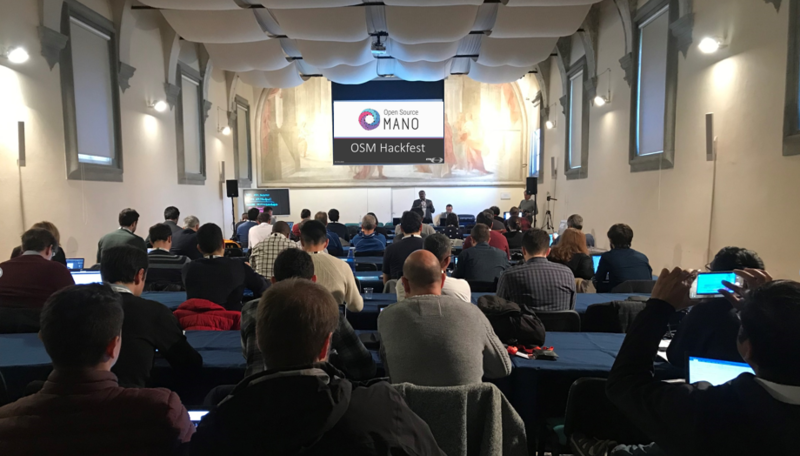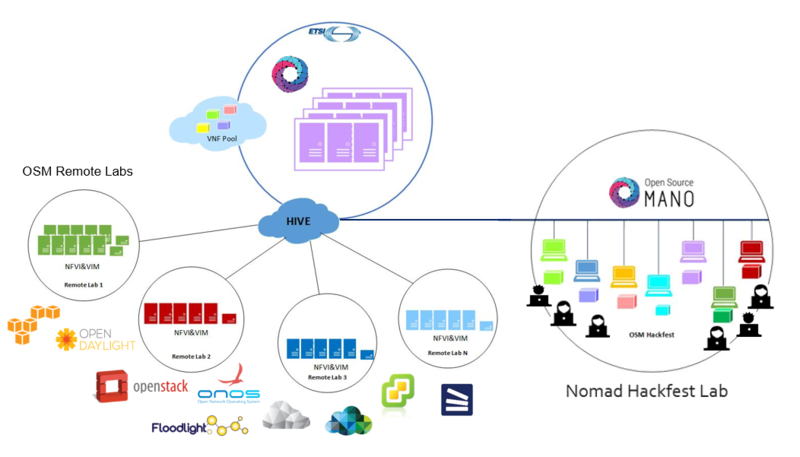8th OSM Hackfest
Overview
ETSI's Centre for Testing and Interoperability and the OSM community are organizing the 8th OSM Hackfest on 18-22 November 2019.
The event will be hosted by 5GCity in Lucca, Tuscany (Italy), co-located with the OSM#8 meeting and a 5GCity Hackfest, offering a great opportunity to share and learn with OSM and 5GCity developers and module leaders, and explore opportunities for synergies and collaboration.
Participation to OSM Hackfests is free and open to all upon Registration
Venue
Il Real Collegio Di Lucca
P.zza del Collegio, 13
55100, Lucca LU
Italy
- Hotel Recommendations and Directions
- Download Visa Invitation Letter (To be completed and sent for signature to Sergi Figerola @ i2cat.net)
Scope
This OSM Hackfest will allow new users to get familiar with OSM Release SIX and exercise all the main functionalities, from basic operations (installation, setup, common operations, etc.) to most advanced capabilities, such as 5G network slicing with a big focus on VNF on-boarding activities covering Day 0/1/2 operations.
In addition, experienced users and developers will have the opportunity to hack into OSM, build complex examples, fine-tune, test and demonstrate Release SEVEN and experimental features on the OSM Remote Labs network.
Objectives
OSM Hackfest participants will learn to :
- Install OSM and run some examples
- Get familiar with OSM's GUI and CLI
- Create basic VNF and NS Descriptors and build own packages
- Model and deploy Advanced Network Services with:
- Multi-VDU VNFs
- Physical and Hybrid Network Functions
- EPA capabilities
- Model dynamic Life Cycle Management operations with Day-1 and Day-2 actions
- Configure Fault and Performance Management and close-loop operations
- Collecting, visualizing and reacting to metrics and events
- Model and Deploy 5G Network Slices
- Configure and Deploy Service Function Chaining
- Contribute, modify and experiment with OSM source code
- Perform basic troubleshooting
- Understand OSM CI/CD and Robot Framework
- Build complex examples and run own experimental testing
Who should attend
- VNF vendors, who want to onboard their VNF in OSM following best practices
- System Integrators, who want to get started with OSM
- Service providers, who want to get first hand operational experience with OSM
- Academia and Universities, who are using or considering OSM as platform for their research activities in networking
- Experimented developers and users that want to share and test with the community
Prerequisites
- Seats are limited, registration is mandatory
- Participants are expected to have user-level knowledge of Linux and be familiar with NFV and SDN concepts
- Laptop
- A remote environment will be made available for participants, if you prefer to install in your own laptop, please follow the default installation procedure. Main requirements:
- MINIMUM: 2 CPUs, 4 GB RAM, 20GB disk and a single interface with Internet access
- RECOMMENDED: 2 CPUs, 8 GB RAM, 40GB disk and a single interface with Internet access
Agenda
- Tentative: Please note the sessions' times and contents may be subject to change
OSM Hackfest Sessions
- Opening, Welcome & Logistics for the week (ETSI, 5Gcity)
- Session 0: Introduction to NFV and OSM (Jose Miguel Guzman - Whitestack)
- Demo 0: OSM in Action (Piotr Zuraniewski - TNO)
- Session 1: OSM Installation and first use (Release SIX) Adrian Candel, Guillermo Calvino - Altran)
- Session 2: Basic Descriptors
- Session 2.1 VNFDs and NSDs (Abubakr Magzoub - Uni Lancaster)
- Session 2.2 Instructions to VNF Providers (Adrian Candel, Guillermo Calvino - Altran)
- Session 3: Modeling multi-VDU VNFs (Adrian Candel, Guillermo Calvino - Altran)
- Session 4: Advanced Descriptors
- Session 4.1: Modeling EPA capabilities in VNF (Tomas Villaseca - Whitestack)
- Session 4.2: Modeling EPA capabilities: SR-IOV (Gianpietro Lavado - Whitestack)
- Session 4.3: Modeling Physical and Hybrid Network Functions (Tomas Villaseca - Whitestack)
- Session 5: Adding Day-0 configuration to your VNF (Adrian Candel, Guillermo Calvino - Altran)
- Session 6: 5G Network Slicing with OSM (Felipe Vicens - Atos)
- Session 7: Adding day-1/day-2 configuration to your VNF
- Session 7.1: Proxy Charms and Primitives (Gianpietro Lavado - Whitestack)
- Session 7.2: Building a Proxy Charm (Mark Beierl - VMware)
- Session 7.3: Native Charms (Dominik Fleischmann, David Garcia - Canonical)
- Session 8: Fault & Performance Management with OSM (Gianpietro Lavado - Whitestack)
- Session 9: VNF On-boarding
- Session 9.1: VNF On-boarding Walkthrough (Gianpietro Lavado - Whitestack)
- Session 9.2: VNF On-boarding to VCD (Mark Beierl - VMware)
- Session 10: Service Function Chaining (Davide Borsatti - Uni Bologna)
- Session 11: CI/CD overview & Robot Framework (Javier Garcia Lloreda - TechMahindra)
- Session 12: How to Contribute to OSM (Javier Garcia Lloreda - TechMahindra)
5G Day: "From Data-centers to the Edge with OSM"
As in previous editions, Wednesday afternoon will be dedicated to 5G experiences, pilots and research projects, this time focusing on Edge deployments. The agenda is as follows:
- Keynote 5G day: An operator's view on the importance of OSM to realize the 5G vision. (Pål Gronsund - Telenor): The presentation will highlight a set of 5G use cases implemented and problems to be solved with OSM as the orchestrator for end-to-end orchestration and automation.
- 5G Day Session 1: Unified 5G Edge Operations Platform (Joe Issaac - Wipro): Wipro's Universal Edge Networks Platform is delivered from our state-of-the-art Digital Operations Center. This is built on a set of best-of-breed products, tightly pre-integrated, with predefined rules and intelligence for a wide range of devices. With a high level of automation and cognitive capability, templatized processes, ready for roll-out, highly self-service-driven, data export facilities to clouds & advanced visualizations, the plaform is scalable to millions of nodes with ability to external integration to data lifecycle tools through a self service interface. This solution is ready to deploy edge-based on Wipro Blueprint available. It can host multiple vertical use cases that will be adopted to leverage 5G edges Use Smart-iConnect, Fan engagement, AirEnF, Analytics, etc.
- 5G Day Session 2: 5G as a Service (5GaaS) – easy access for 3rd parties to 5G technology (Piotr Zuraniewski - TNO): Presentation of initial ideas about TNO 5G-as-a-Service (5GaaS) PoC platform. The aim of the platform is to provide engineers from the field of Information Technology (IT) with access to specific features of 5G cellular network technology, without requiring them to have an expert level understanding of the mobile technology involved. At the same time, the PoC platform also adds value to experts in 5G in terms of support for carrying out research on 5G services and technology.
- 5G Day Session 3: Orchestration of 5GCity edge computing with OSM: pilot trials and lessons learnt (Shuaib Siddiqui - i2CAT): The 5GCity project is developing a distributed cloud and radio platform for municipalities and infrastructure owners acting as 5G Neutral Hosts. We orchestrate a completely decentralised 3-tier architecture where compute, storage and networking are allocated between core and edge segments of the 5G network infrastructure. Our unified orchestration platform includes ETSI OSM at its core to deliver 5G Network Services in sliced city infrastructures in Barcelona (ES), Bristol (UK) and Lucca (IT). We primarily run trials of Media Verticals use cases to assess how a Neutral Host operator can offer mobile connectivity solutions on demand. Through our platform and with ETSI OSM Release 6 we implement dedicated network slices for different media services in areas with a high concentration of users. The network edge is very critical for our project in terms of design and orchestration of multiple tiers. We have developed a multi-tier orchestrator to control OSM and fog05 MEAO, in addition to using fog05 as VIM in OSM. In this talk we will present experiences with OSM from or pilot trials and we will share some lessons learnt.
- 5G Day Session 4: NetworkDevOps (netOps.ai 2.0) with Continuous Orchestration (Manish Singh - Tech Mahindra): A complete automated Telco grade PAAS solution for 4G/5G functions with continuous release management, functional & performance validation, monitoring & continuous orchestration using OSM. The entire scope of the PAAS solution is targeted to run multi-VNF LCM functionalities & provisioning 4G/5G network services orchestrated using OSM followed by certification procedures. Smooth rollout of the Production Sites & multi-vendor VNF deployments with any underneath Infra & Edge components. Providing CSP a clear idea about their 4G/5G Telco Cloud solution performance & OPEx. Using netops.ai CSP can evaluate any combination of multi-vendor composition & choose the best blended Telco cloud Infra & VNF to create the required network service.
- 5G Day Session 5: 5G-ready applications in Matilda - Demo (Roberto Bruschi, Chiara Lombardo - CNIT): Part of the scope of the Matilda project is to design and develop a radically new prototypic framework of the Telecom Layer Platform able to support functional and performance requirements, as well as the effective lifecycle management of 5G-ready Vertical Applications. For that, we built a highly modular architecture aimed to dynamically control, abstract, and suitably expose the 5G network infrastructure resources and services to vertical applications in terms of network and computing slices, taking advantage of in OSM for managing the lifecycle and configuration of the network functions.
- 5G Day Session 6: Cognitive-driven Orchestration and Optimization of Cloud to Edge virtualized Content Delivery Networks (Francesca Moscatelli - Nextworks): The “Ultra High Definition over virtualized Content Delivery Network” Pilot developed in the context of the EU funded 5G-MEDIA project (H2020 5GPPP phase 2 Innovation Action) shows how Media Service Providers can build flexible, adaptable and distributed core-to-edge vCDN services. Relying on the capabilities offered by the 5G-MEDIA Service Virtualization Platform, built around ETSI OSM, the adaptation and optimization of the service is performed at the edge of the network upon monitored application metrics and detected anomalies in traffic flows; the service chain is then re-adapted and re-configured automatically and dynamically for offering to the end-user a better QoE.
- 5G Day Session 7: Multi-site orchestration of end-to-end 5G networks: the 5G EVE approach for the inter-working of multiple 5G experiment facilities. (Francesco Lombardo, Matteo Pergolesi - CNIT): The goal of 5G EVE is to provide a 5G platform for extensive trials of network services hosted on various European trial sites (Greece, Spain, France, and Italy). The interconnection and inter-operation between remote sites in different network domains is a big challenge. We introduce the concept of the Inter-Working Layer (IWL), a middle-ware to provide a common catalog of Network Service Descriptors, a common Life-Cycle Manager, and a Multi-Site top-level Orchestrator able to deploy and manage network services hosted on a single site or split on multiple sites. The OSM orchestrator is used in the trial sites of Turin (Italy) and Madrid (Spain). The usage of the platform is made user-friendly by the definition of high-level, intent-based blueprints to describe vertical services.
- 5G Day Wrap-up: Mini-panel to resume, compare and sum up the findings from the previous presentations
Hackfest Material
Remote Labs
During OSM Hackfests participants build and try real examples of OSM interaction with different VIMs and NFV Infrastructures that are kindly made available by our community members through the OSM Remote Labs network.
Previous Hackfests
- 7th OSM Hackfest - Patras (Greece)
- 6th OSM Hackfest - Santa Clara (CA, USA)
- 5th OSM Hackfest - Barcelona (Spain)
- 4th OSM Hackfest - Palo Alto (CA, USA)
- 3rd OSM Hackfest - Oslo (Norway)
- 2nd OSM Hackfest - Madrid (Spain)
- 1st OSM Hackfest - Sophia Antipolis (France)
Get involved in OpenSourceMANO
- Join the OSM Community Slack Workspace
- If your organisation is already an OSM member, you can also:
- Request an EOL account (if you don’t have one yet)
- Subscribe OSM general and OSM TECH mailing lists
- If your organisation is not yet an OSM member:
- Learn how to join, it is free and open to all
- Join the OSM Ecosystem
Contact
Please send your technical questions to OSM_TECH@list.etsi.org or join the OSM Community Slack Workspace
Questions about ETSI, joining OSM, this hackfest and future events can be sent to: OSMSupport@etsi.org




